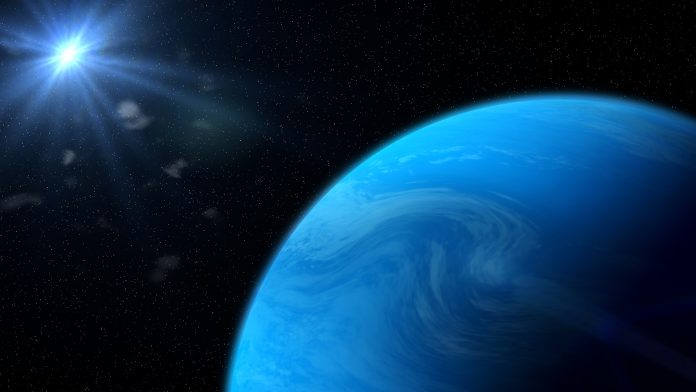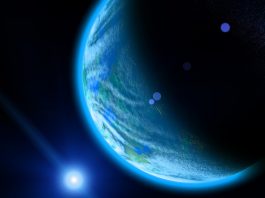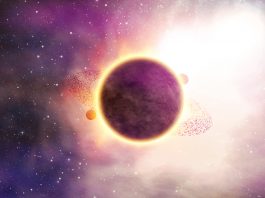Astronomers from the University of Montreal have discovered that two exoplanets may be comprised of mostly water.
Astronomers from the University of Montreal have found evidence that suggests that two exoplanets orbiting a red dwarf star are ‘water worlds,’ where water makes up the majority of the planet. These exoplanets, located 218 light-years away in the constellation Lyra, are unlike any others found in our solar system.
The study, ‘Evidence for the volatile-rich composition of a 1.5-Earth-radius planet,’ is published in the journal Nature Astronomy.
Observing the composition of the two exoplanets
The astronomers, led by PhD student Caroline Piaulet, who is part of Björn Benneke’s research team at the University of Montreal, observed exoplanets Kepler-138c and Kepler-138d with NASA’s Hubble and the retired Spitzer space telescopes. From this, they discovered that the planets, which are approximately one and a half times the size of Earth, could be comprised of mostly water.
Although water was not directly detected, the researchers compared the sizes and masses of the exoplanets to models, ultimately concluding that up to half of their volume should be made of materials that are lighter than rock but heavier than hydrogen or helium. It is likely for this material to be water.
“We previously thought that planets that were a bit larger than Earth were big balls of metal and rock, like scaled-up versions of Earth, and that’s why we called them super-Earths,” explained Benneke.
“However, we have now shown that these two planets, Kepler-138c and d, are quite different in nature: a big fraction of their entire volume is likely composed of water. It is the first time we’ve observed planets that can be confidently identified as water worlds, a type of planet that was theorised by astronomers to exist for a long time.”
Surprisingly, planets c and d have much lower densities than Earth but have volumes three times the size of our planet. This is unusual, as most of the previously studied exoplanets that are slightly bigger than Earth appear to be rocky. The researchers believe that the closest comparison to the two exoplanets are some of the icy moons in the outer solar system that are also comprised of mostly water surrounding a rocky core.
“Imagine larger versions of Europa or Enceladus, the water-rich moons orbiting Jupiter and Saturn, but brought much closer to their star,” explained Piaulet. “Instead of an icy surface, Kepler-138 c and d would harbour large water-vapour envelopes.”
These exoplanets may not have oceans like those on Earth which are directly at the planet’s surface.
“The temperature in Kepler-138c’s and Kepler-138d’s atmospheres is likely above the boiling point of water, and we expect a thick, dense atmosphere made of steam on these planets. Only under that steam atmosphere there could potentially be liquid water at high pressure, or even water in another phase that occurs at high pressures, called a supercritical fluid,” Piaulet said.
Another team at the University of Montreal have recently discovered another exoplanet, called TOI-1452 b, that could potentially be covered with a liquid-water ocean. To confirm the presence of the ocean, NASA’s James Webb Space Telescope will be used to study its atmosphere.
Detecting a new planet
In 2014, data from NASA’s Kepler Space was used to detect three exoplanets orbiting Kepler-138, a red dwarf star in the constellation Lyra. This was based on a measurable dip in starlight as the planet passed in front of the star.
From this, the astronomers decided to re-observe the planetary system with the Hubble and Spitzer space telescopes to catch more transits of Kepler-138d, the third planet in the system, studying its atmosphere.
The NASA Kepler space telescope observations only showed transits of three small planets around Kepler-138, but the Hubble and Spitzer observations suggested the presence of a fourth planet in the system: Kepler-138e.
This planet is small and farther from its star than the three others, taking 38 days to complete an orbit. The exoplanet is located in the habitable zone of its star, where a planet receives the right amount of heat to be neither too hot nor too cold to allow the presence of liquid water.
However, the nature of this newly discovered exoplanet remains an open question because it does not appear to transit its host star, which leaves the researchers unable to determine its size.
As the astronomers found Kepler-138e, the masses of the other planets were measured again with the transit timing-variation method. This involves tracking small variations in the precise moments of the planets’ transits in front of their star caused by the gravitational pull of other nearby planets.
The researchers also discovered that the two water-filled exoplanets, Kepler-138c and d, are twin planets, with approximately the same size and mass, while they were previously thought to be drastically different. Kepler-138b, however, is confirmed to be a small Mars-mass planet, one of the smallest exoplanets known to date.
“As our instruments and techniques become sensitive enough to find and study planets that are farther from their stars, we might start finding a lot more water worlds like Kepler-138 c and d,” Benneke concluded.









